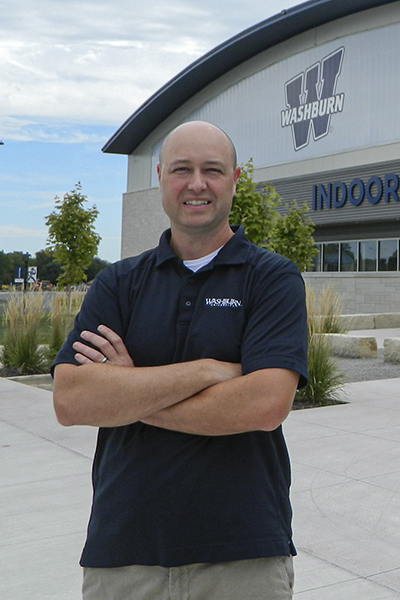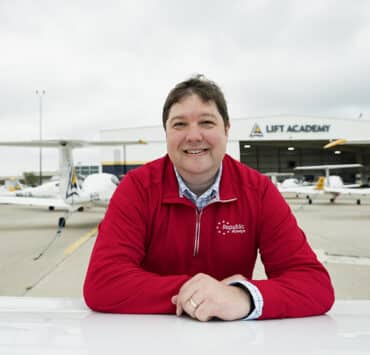|
Getting your Trinity Audio player ready...
|
Like a lot of people in the construction business, Eric Just serves a customer base. But what makes his job different from others in his line of work is that his customers also form a community.

As the director of facilities services at Washburn University in Topeka, Kansas, Just manages campus projects; handles day-to-day procedures regarding custodial work, landscaping, and building maintenance; and is also charged with directing the physical aspects of the campus as plans are made for the future. It’s a job that balances long-range planning with fulfilling the immediate needs of faculty, staff, and students.
“You’re trying to create a relationship and an environment where [people] enjoy being and have good things to say, because a lot of higher education is about word of mouth,” Just shares. “They’re going to talk to friends and relatives [about] the things they think can have a large impact on the university as a whole. So, we’re really trying to put our best foot forward.”
Just’s original goal when he started his own undergraduate studies at Kansas State University was to become a mechanical engineer.
“I’ve always been a problem-solver, so what I liked about the construction side was the physical aspect of it—you see the work going on and even participate in it. It’s a hands-on situation.”
“I actually changed that while I was at college and went into construction science management,” he recalls. “I’ve always been a problem-solver, so what I liked about the construction side was the physical aspect of it—you see the work going on and even participate in it. It’s a hands-on situation.”
After graduating in 2005, he worked for a general contractor in Las Vegas, then returned to Kansas City to lend his expertise to a general contractor before moving to work for a local utility company, Westar, which is now Evergy.
“I participated in some big industrial projects for them; they were implementing environmental pollution control upgrades on some of their coal-fired power plants,” Just says of Evergy. “I got to see a lot of different systems and aspects on the industrial side and helped them solve some problems.”
The education sector was a new endeavor for Just when he joined Washburn in June 2019, and that, he explains, has created an opportunity to learn and grow.
“Certainly, the projects are right up my alley,” Just says. “The things that I’m still learning about are on the academic side—that’s a whole different world to me. We’re really focused on the faculty and what they can provide to the students and making sure we’re providing a campus and an environment that’s attractive to students, so that we can continue to keep our enrollment stable, or even potentially increase it, if possible. It’s very much customer oriented.”
His past work focused on production, safety, and any urgent situation that developed. In higher education, he has to contribute to environments where students can learn and faculty members can teach, while also ensuring that facilities are running smoothly.
“Washburn is continuing to expand and trying to attract people by having new and improved facilities on campus.”
Two key construction projects he has contributed to since joining the university include the new indoor athletic facility and new law school. Construction on the athletic facility began in 2018, under the previous director. The result is an impressive metal building with an indoor turf field that’s being used for football and soccer, as well as the occasional baseball and softball practice.
“It also houses an indoor track,” Just says. “It’s a 200-meter banked track, and there’s room for long jump, triple jump, pole vaulting, and high jump, and there’s also a shotput-throwing area. It’s a pretty impressive place that was completed in December and cost about $20 million.”
The building for the Washburn University School of Law is a new project, as far as construction goes. It only recently held its groundbreaking, but work and fundraising on the project began a decade prior.
“We jumped into design with our architects, and from 2019 into 2020, we went through design and a bidding process, selected a general contractor, and went through building permitting locally,” Just explains. “It was about an 11-year process for Washburn from the inception of the project to get to this point of ground-breaking.”
The law school is a $35 million project, and the changing needs of the faculty and students have influenced the building’s design. For example, physical books are less of a priority now, as people rely more on online resources, which means less square footage for the library. The school will feature offices and classrooms, as well as two courtrooms that will be used for practice trials and as classrooms.
“They also can host actual court sessions,” Just says. “So, the Kansas Supreme Court will come in and actually hold trials there. We’re pretty excited about that.”
Construction is expected to last 18 months, with plans calling for the building to open for the spring 2023 semester.
“It’s the largest project Washburn has done, as far as a dollar figure goes, but there have been several important projects over the past couple of decades,” Just says. “Washburn is continuing to expand and trying to attract people by having new and improved facilities on campus.”
That kind of philosophy is what inspires Just and his team to put their efforts into ensuring that the expectations of the university’s students, faculty, and staff are not only met but exceeded.


